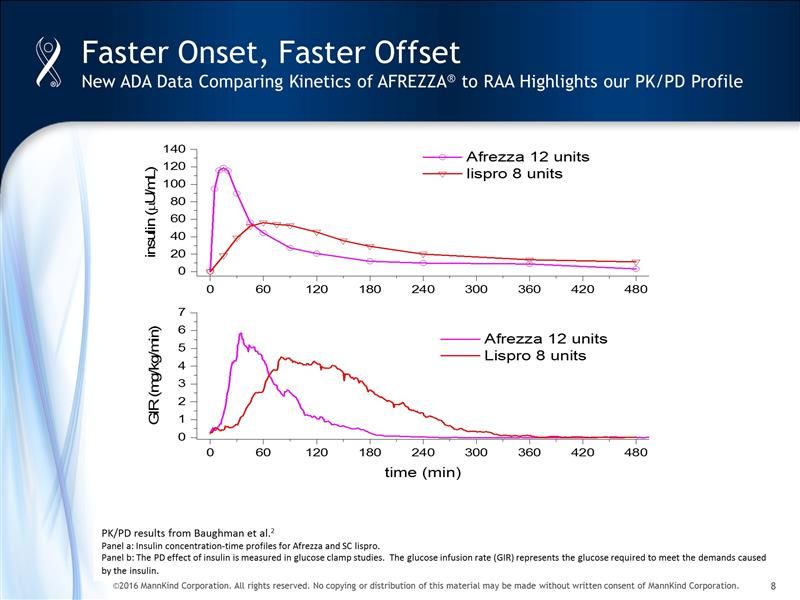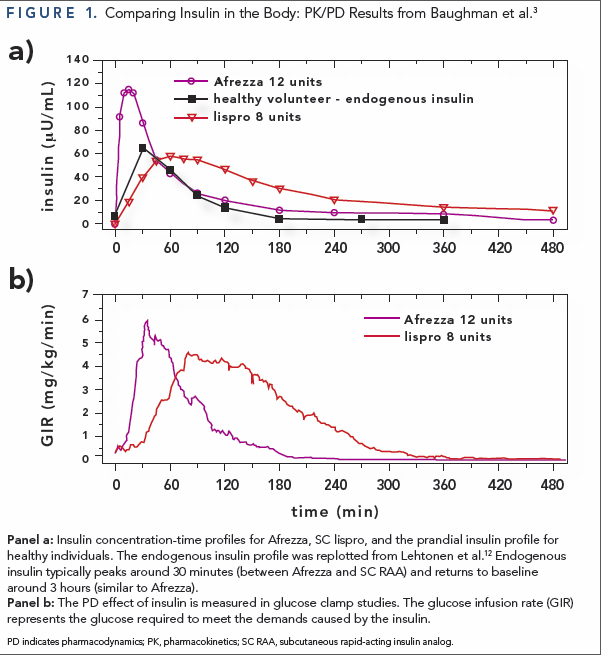|
|
Post by gonetotown on Sept 28, 2016 10:06:04 GMT -5
Baughman RA, Heise, Grant ML, et al. Technosphere insulin inhalation powder (TI) displays earlier onset and shorter duration than insulin lispro (lispro). Diabetes. 2016;65(suppl 1A):100-LB.
It was quoted in one of the AJMC articles but I can't find a complete copy anywhere.
|
|
|
|
Post by mnholdem on Sept 28, 2016 10:13:53 GMT -5
|
|
|
|
Post by gonetotown on Sept 28, 2016 10:36:15 GMT -5
|
|
|
|
Post by peppy on Sept 28, 2016 10:53:21 GMT -5
I see what you mean different graph and because this one is a different afrezza dose. 12 u afrezza rather than 8 unit afrezza dose shown, by memory. ajmc.s3.amazonaws.com/_media/_pdf/EBDM0916.pdf look at the words used in the meta analysis at left, positive as can be. screencast.com/t/7273Jsj3bZ
besides all the positive things the meta analysis was saying, it said this.
"A 4 unit cartridge reduces my glucose 30 mg/dl in 90 minutes."
I stare at this because of use like mike H indicting, corrections.
Additionally, in the meta analysis that users are dropping the pump.
cost savings...
|
|
|
|
Post by matt on Sept 28, 2016 11:03:26 GMT -5
What you posted is not an article, it is probably just a citation to the abstract. Abstracts are generally published as a supplement after the meeting, and there are no articles in press by that author on the magazine web site (there might be in the future).
|
|
|
|
Post by peppy on Sept 28, 2016 11:51:38 GMT -5
What you posted is not an article, it is probably just a citation to the abstract. Abstracts are generally published as a supplement after the meeting, and there are no articles in press by that author on the magazine web site (there might be in the future). It has positive words to say, what ever it is. cost effective corrects problem (referring to type two on insulin) screencast.com/t/2gNn5UWKXA ajmc.s3.amazonaws.com/_media/_pdf/EBDM0916.pdf
|
|
|
|
Post by mnholdem on Sept 28, 2016 13:44:49 GMT -5
What you posted is not an article, it is probably just a citation to the abstract. Abstracts are generally published as a supplement after the meeting, and there are no articles in press by that author on the magazine web site (there might be in the future). Yep. I think it's the Poster presented at the ADA-2016. |
|
|
|
Post by pengiep on Sept 28, 2016 14:58:35 GMT -5
|
|
|
|
Post by gonetotown on Sept 28, 2016 19:49:38 GMT -5
What you posted is not an article, it is probably just a citation to the abstract. Abstracts are generally published as a supplement after the meeting, and there are no articles in press by that author on the magazine web site (there might be in the future). But the AJMC article footnotes it as the source of those graphs in figure 1, so where else would the author get the graphs? The thing is that the graph compares 12U of afrezza to 8U of lispro, but the graphs don't match the poster results. In the AJMC article, the GIR peaks at 600 for 12U of afrezza and at 400 for 8U of lispro. In the poster, the GIR for 12U of afrezza peaked at 400, not at 600 . The footnote suggests the data used came from the ADA abstract, but the graphs suggest otherwise. Why the difference? |
|
|
|
Post by mnholdem on Sept 29, 2016 6:52:15 GMT -5
What you posted is not an article, it is probably just a citation to the abstract. Abstracts are generally published as a supplement after the meeting, and there are no articles in press by that author on the magazine web site (there might be in the future). But the AJMC article footnotes it as the source of those graphs in figure 1, so where else would the author get the graphs? The thing is that the graph compares 12U of afrezza to 8U of lispro, but the graphs don't match the poster results. In the AJMC article, the GIR peaks at 600 for 12U of afrezza and at 400 for 8U of lispro. In the poster, the GIR for 12U of afrezza peaked at 400, not at 600 . The footnote suggests the data used came from the ADA abstract, but the graphs suggest otherwise. Why the difference? It's possible that the author designed the graph himself using the data table from 100-LB. It's similar to the graph that MannKind used at the Rodman & Renshaw conference and they probably did the same:

However, you'll note that the Campbell added a third black line (see graph below) for endogenous insulin which he states in the footnotes is "replotted from Lehtonen, et. al."

It's entirely possible, IMHO, that this particular graph exists nowhere outside the confines of the amjc article.
|
|
|
|
Post by gonetotown on Sept 29, 2016 8:13:19 GMT -5
But it says "PK/PD Results from Baughman et al" and then references footnote "3" which is this:
Baughman RA, Heise, Grant ML, et al. Technosphere insulin inhalation powder (TI) displays earlier onset and shorter duration than insulin lispro (lispro). Diabetes. 2016;65(suppl 1A):100-LB.
That title is the same as the ADA abstract. If this reference is using different data, where did that data come from? Why is it different from the data presented ADA abstract? The GIR for afrezza in the article graph is 50% larger than that shown the graph in the abstract.
|
|
|
|
Post by mnholdem on Sept 29, 2016 8:38:55 GMT -5
It's possible that the disparity is because the Baughman report plots in hours, which may have resulted in some rounding within the GIR graph, while both MannKind's and Campbell's graphs show GIR in minutes, which catches the peak. Just speculating, but you could also try contacting the company CMO Dr. Urbanski. He might be able to explain or even provide source data.
Have at it... or should I say, "Go To Town".
|
|
|
|
Post by gonetotown on Sept 29, 2016 8:45:17 GMT -5
It's possible that the disparity is because the Baughman report plots in hours, which may have resulted in some rounding within the GIR graph, while both MannKind's and Campbell's graphs show GIR in minutes, which catches the peak. Just speculating, but you could also try contacting the company CMO Dr. Urbanski. He might be able to explain or even provide source data. Have at it... or should I say, "Go To Town". The MNKD website doesn't have any email addresses for anyone. The abstract lists "RBaughman@mannkindcorp.com" so I'll give that a shot. |
|
|
|
Post by peppy on Sept 29, 2016 9:11:17 GMT -5
Cmax and AUC for Afrezza and Lispro were approximately doseproportional
over the dose range studied
• Each 4 unit Afrezza cartridge provides approximately the same
insulin exposure as 3.1 U Lispro
• For matched doses providing the same GIR AUC:
• Every quantile of Afrezza’s GIR and GIR AUC curves
occurs before the corresponding point on the Lispro
curves
• Afrezza’s onset of action is faster than Lispro’s
• Afrezza’s duration is shorter than Lispro’s
• Afrezza’s labeled dose over-estimates its effect
• A single conversion factor does not fully describe Afrezza’s <------------ the first phase insulin respone? screencast.com/t/AhnFhHunq
effect relative to SC insulin
• For safety, initial conversion to Afrezza tends to underestimate
dose
• Titration to appropriate dose is essential
www.mannkindcorp.com/Collateral/Documents/English-US/Baughman%20poster%20100-LB%20FINAL%20X2.pdf
Reference and disclosure; [1] Boss AH, Petrucci R, Lorber D. Coverage of prandial insulin requirements by means of an ultrarapid-
acting inhaled insulin. J Diabetes Sci Technol. 2012;6(4):773-9.
Disclosures
• Clinical study was performed and funded by Sanofi.
• MG and RB are employees of Mannkind.
• PG, LP, YH, BG and RD are employees of Sanofi.
• TH is an employee of Profil, Germany and is a member of advisory panels for Novo Nordisk;
received travel funds and honoraria from Eli Lilly, Mylan, and Novo Nordisk; conducted
research sponsored by Adocia, Astra Zeneca, Becton Dickinson, Biocon, Boehringer
Ingelheim, Dance Pharmaceuticals, Eli Lilly, Grünenthal, Gulf Pharmaceuticals,
Johnson&Johnson, Marvel, Medimmune, Medtronic, Novartis, Novo Nordisk, Roche
Diagnostics, Sanofi, Senseonics, Zealand Pharma
Afrezza®, Technosphere®, the Afrezza symbol and the MannKind logo are registered trademarks of
(Part of one big nervous system.)
|
|